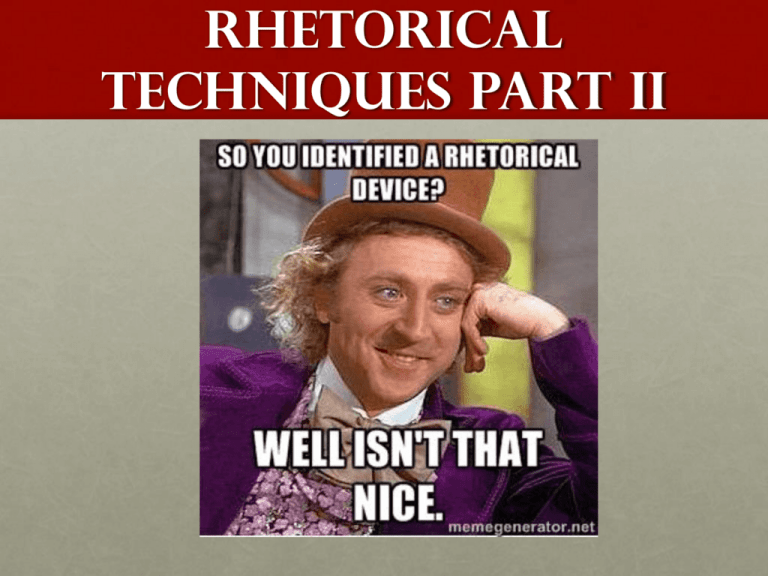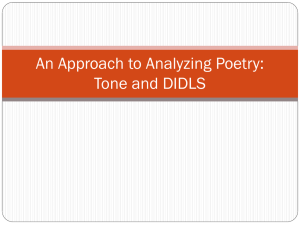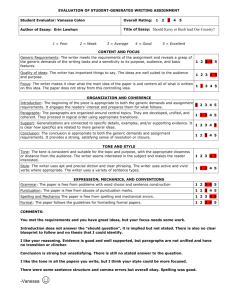Rhetorical Techniques Part II
advertisement

Rhetorical Techniques Part II TONE What is TONE? • the author’s (or speaker’s) attitude toward the subject What is TONE NOT? • It is not MOOD – how the writer or speaker wants us to feel • Think about the character Dwight on The Office. His TONE is often very serious, determined, and even angry… • but the MOOD the writers are trying to create for us is humorous. What is TONE NOT? • It’s not the SUBJECT of the passage; it’s the author/speaker’s ATTITUDE towards that particular subject. Opening stanza of the poem “Because I Could Not Stop for Death” by Emily Dickinson Because I could not stop for Death— He kindly stopped for me— The Carriage held but just Ourselves— And Immortality The subject of this poem is death. But, what does Dickinson compare death and dying to in this opening stanza? How do these choices effect the TONE? HOW DO WE FIGURE OUT AN AUTHOR’S TONE? While there are many author choices to consider, let’s focus on three main elements: • Diction: specific word choices • Imagery: words and phrases that appeal to any of our five senses • Figurative Language: language that communicates ideas beyond the literal meaning of words. DICTION – the words the writer chooses Words have a DENOTATION--the literal meaning (s) we find in a dictionary A common definition of terrorist: any one who attempts to further his views by a system of coercive intimidation DICTION – the words the writer chooses But words also have a CONNOTATION--the ideas and emotions we associate with a word, which can be subjective and can change over time Presently, there is great debate about when to use the term “terrorist” because of ideas, images, and feelings we associate with this word. terrorist vs. revolutionary vs. rebel vs. radical vs. extremist—these words have different connotations DICTION – the words the writer chooses Consider a word’s CONNOTATION (the ideas and emotions we associate with a word—which can be subjective and can change over time) • pruning the bushes vs. slashing the bushes • the politician’s stance vs. the politician’s spin • assertive vs. pushy • childish vs. youthful • chatty vs. conversational • lovely vs. a knockout • mutt vs. dog DICTION – the words the writer chooses Formal Informal Colloquial (Slang) police officer cop the Fuzz significant other boyfriend/girlfriend home skillet/bae elegant apparel dressed up fancy pants IMAGERY “There is no retreat but in submission and slavery! Our chains are forged! Their clanking may be heard on the plains of Boston!” ~Patrick Henry in his speech to the Virginia Convention • Which of our five senses (taste, touch, sound, sight, smell) do Henry’s choices appeal to? • What are the connotations—the feelings we associate with these images? FIGURATIVE LANGUAGE • “Sir, we have done everything that could be done, to avert the storm which is now coming on.” ~Patrick Henry in his speech to the Virginia Convention • What is being compared to what in this indirect metaphor? • What is the connotation—the feelings we associate with the figurative language Henry has chosen? What signals a TONE shift? • BUT! Always be on the lookout for “buts” and any other transition words that signal a change, such as yet, nevertheless, however, etc. • Changes in syntax. After a really long sentence, does the author emphasize a shift with a really short sentence? • Contrast and juxtaposition (of images, ideas, words, etc.) • A new paragraph parallel structure/parallelism • using the same grammatical structure or pattern of words, phrases, or clauses to show that two or more ideas have the same level of importance “…government of the people, by the people, for the people shall not perish from the earth.” This is specific type of parallelism known as a TRICOLON (three parallel words, phrases, or clauses repeating). This is a very popular persuasive tool. A list of three can have a powerful effect on an audience or reader. parallel structure Nonparallel structure looks like this: • After school we went , , and • After school we ate nachos, learned Greek, and then we did back flips off a roof. Parallel structure looks like this: • After school we , , , and . • After school we ate nachos, learned Greek, and chugged Dr. Pepper. parallel structure "Our transportation crisis will be solved by a bigger plane or a wider road, mental illness with a pill, poverty with a law, slums with a bulldozer, urban conflict with a gas, racism with a goodwill gesture." ~Philip Slater, The Pursuit of Loneliness. parallel structure "Our transportation crisis will be solved by a bigger plane or a wider road, comparative adjective/noun comparative adjective/noun mental illness with a pill, poverty with a law, slums with a bulldozer, urban conflict with a gas, noun/prepositional phrase structure repeats. These two are slightly less parallel because the writer added an adjective modifier before the noun. racism with a goodwill gesture." parallel structure "Humanity has advanced, when it has advanced, not because it has been sober, responsible, and cautious, but because it has been playful, rebellious, and immature. Notice – parallel structure is not about merely repeating words. All the words can be different. It’s the grammatical pattern that repeats. ~Tim Robbins, actor/writer/director parallel structure "Humanity has advanced, when it has advanced, not because it has been sober, responsible, and cautious, but because it has been playful, very rebellious, and sometimes dominated by a state of immaturity.” Here is a NONPARALLEL version of the same quote. Why is it not parallel? antithesis • two opposite ideas are juxtaposed in a sentence with parallel structure to emphasize the contrast Example: “That’s one small step for man; one giant leap for mankind.” ~Astronaut, Neil Armstrong Example: “It was the best of times, it was the worst of times, it was the age of wisdom, it was the age of foolishness…” ~Opening of Charles Dickens’s novel A Tale of Two Cities anecdote • a short, interesting or amusing account/story of an experience used by a speaker or writer to illustrate a point or advance an argument • In The Crucible when John Proctor is trying to show Rev. Hale why he doesn’t respect Rev. Parris, he tells the anecdote about the golden candlesticks to make his point • Not to be confused with an antidote-something used to counteract the effects of a poison or other undesirable element. aphorism • A brief cleverly-worded statement, usually one sentence long, that expresses a general principle or truth about life. • Examples of aphorisms Ben Franklin wrote: - “Life's tragedy is that we get old too soon and wise too late.” - “We are all born ignorant, but one must work hard to remain stupid.”






